Gorgeous Rare Navajo Coin Silver Domed Dime Concho Belt Buckle

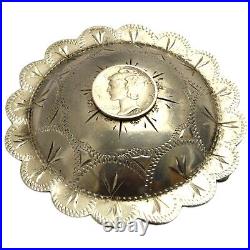
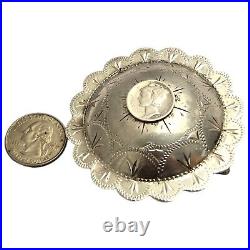
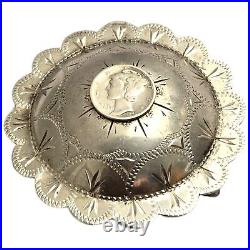
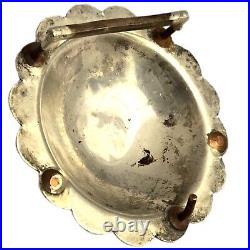
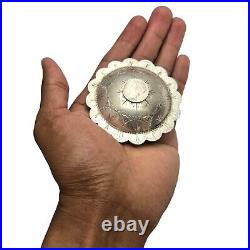

This is an incomparable vintage Navajo buckle! It features a 1943 dime coin dome silver concho with intricate hand carved and hand stamped designs, and will fit a belt with a width of 1¾ So Sensational! No marks but tested as Sterling silver, the back has copper on the back please see photos The buckle measures around 2″¾ x2″¾Sturdy 43.5grams. Silverwork is a relatively recent form of Indian art work since silver mines did not exist in the American Southwest. The Navajo Indians were the first to adopt the craft, but this wasn’t until the mid 1800s when silver became more readily available. The primary sources of silver in Navajo jewelry were often coins or flatware which were obtained through trade. Smiths would melt down silver to cast into an ingot, or block. The ingot was then hammered into a flat sheet and worked into a finished design. It was smoothed down with stones and then polished with sand or ashes. Navajo silversmiths also made use of stone molds with pre-carved designs, an extremely time-consuming process. During the early 1900s, the expansion of the Santa Fe Railroad into the American Southwest created a huge demand for inexpensive Indian-made curios. The need for financial security prompted many Indian artisans to go to work in commercial jewelry factories to mass-produce souvenirs for tourists. Non-traditional motifs and elaborate decoration were adopted in order to make Indian jewelry more appealing to the masses. As discerning collectors, the Pabsts sought out these types of Indian art. With the onset of the Great Depression followed by World War II, the demand for Indian jewelry waned, creating an economic crisis for the Navajo people. In 1934, the U. Congress passed the Indian Reorganization Act which gave tribes the right to govern themselves in an attempt to restore tribal identity and traditional ways of life. The following year, the Indian Arts and Crafts Board was created to assist Native American silversmiths by helping them establish new markets for their goods. Vocational schools were founded specifically to teach the silversmith trade, and these artisans enjoyed a growing patronage by collectors and museums. In decades since, Native American artisans have become more professionalized and individualistic in their approaches to jewelry design. Some contemporary Southwest jewelry is fashioned from steel or titanium. Other designers favor more traditional techniques and materials. The appeal of Native American jewelry – both antique and modern – has withstood the test of time.
